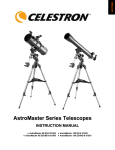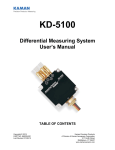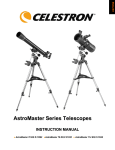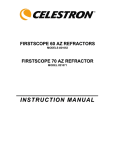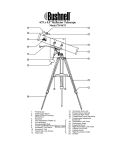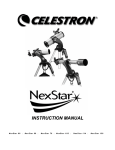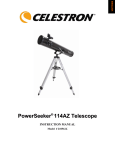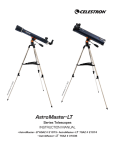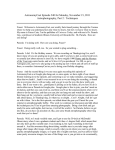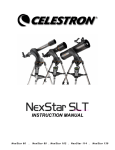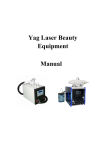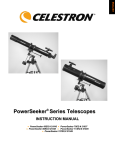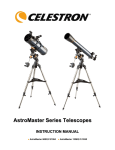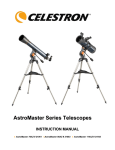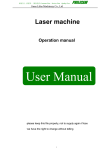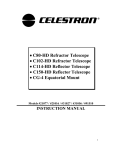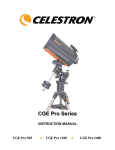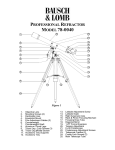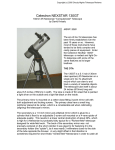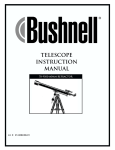Download Celestron SkyScout Scope 90 User's Manual
Transcript
INSTRUCTION MANUAL Table of Contents INTRODUCTION .......................................................................................................................... 3 ASSEMBLY ................................................................................................................................... 5 Setting up the Tripod .................................................................................................................. 5 Moving the Telescope Manually ................................................................................................ 6 Attaching the Telescope Tube to the Mount............................................................................... 6 Installing the Diagonal & Eyepieces........................................................................................... 7 Aligning the Finderscope............................................................................................................ 7 Attaching the SkyScout............................................................................................................... 8 Aligning the SkyScout ................................................................................................................ 8 TELESCOPE BASICS ................................................................................................................... 9 Focusing...................................................................................................................................... 9 Calculating Magnification .......................................................................................................... 9 Determining Field of View ....................................................................................................... 10 General Observing Hints........................................................................................................... 10 CELESTIAL OBSERVING ......................................................................................................... 11 Observing the Moon ................................................................................................................. 11 Observing the Planets ............................................................................................................... 11 Observing the Sun..................................................................................................................... 11 Observing Deep Sky Objects .................................................................................................... 12 Seeing Conditions ..................................................................................................................... 12 TELESCOPE MAINTENANCE .................................................................................................. 13 Care and Cleaning of the Optics ............................................................................................... 13 OPTIONAL ACCESSORIES ..................................................................................................... 14 TECHNICAL SPECIFICATIONS ............................................................................................... 15 2 Congratulations on your purchase of the SkyScout Scope. The SkyScout Scope is made of the highest quality materials to ensure stability and durability. All this adds up to a telescope that gives you a lifetime of pleasure with a minimal amount of maintenance. This telescope was designed for use with the Celestron SkyScout Personal Planetarium (sold separately). The SkyScout Scope features a compact and portable design with ample optical performance to excite any newcomer to the world of amateur astronomy. In addition, your SkyScout Scope is ideal for terrestrial observations which will open your eyes with superb high power viewing. The SkyScout Scope carries a two year limited warranty. For details see our website at www.celestron.com Some of the many standard features of the SkyScout Scope include: • All coated glass optical elements for clear, crisp images. • Special metals used to minimize magnetic interference of SkyScout. • Smooth functioning, rigid alt-azimuth mount with a large pan handle with built-in clutch for easy targeting. • Preassembled steel leg tripod with 1.25” legs ensures stable platform. • Quick and easy no-tool set up. • The SkyScout Scope can be used terrestrially as well as astronomically with the standard accessories included. Take time to read through this manual before embarking on your journey through the Universe. It may take a few observing sessions to become familiar with your telescope, so you should keep this manual handy until you have fully mastered your telescope’s operation. The manual gives detailed information regarding each step as well as needed reference material and helpful hints guaranteed to make your observing experience as simple and pleasurable as possible. Your telescope is designed to give you years of fun and rewarding observations. However, there are a few things to consider before using your telescope that will ensure your safety and protect your equipment. Warning • Never look directly at the sun with the naked eye or with a telescope (unless you have the proper solar filter). Permanent and irreversible eye damage may result. • Never use your telescope to project an image of the sun onto any surface. Internal heat build-up can damage the telescope and any accessories attached to it. • Never use an eyepiece solar filter or a Herschel wedge. Internal heat build-up inside the telescope can cause these devices to crack or break, allowing unfiltered sunlight to pass through to the eye. • Do not leave the telescope unsupervised, either when children are present or adults who may not be familiar with the correct operating procedures of your telescope. 3 3 1 2 4 5 6 12 7 8 9 11 10 Figure 1-1 SkyScout Scope 90mm Refractor 1. 2. 3. 4. 5. 6. Objective Lens Telescope Optical Tube SkyScout (not included) SkyScout Bracket Finderscope Eyepiece 7. 8. 9. 10. 11. 12. 4 Erect Image Diagonal Focuser Pan Handle Tripod Accessory Tray Alt-Az Mount This section covers the assembly instructions for your SkyScout Scope. Your telescope should be set up indoor the first time so that it is easy to identify the various parts and familiarize yourself with the correct assembly procedure before attempting it outdoor. Each SkyScout Scope includes – optical tube with attached SkyScout bracket , Alt-Az mount with attached pan handle, 10mm eyepiece – 1.25”, 40mm eyepiece – 1.25”, erect image diagonal - 1.25” . Setting up the Tripod 1. 2. 3. 4. Remove the tripod from the box (Figure 2-1). The tripod comes preassembled so that the set up is very easy. Stand the tripod upright and pull the tripod legs apart until each leg is fully extended and then push down slightly on the tripod leg brace (Figure 2-2). The very top of the tripod is called the tripod head. Next, we will install the tripod accessory tray (Figure 2-3) onto the tripod leg brace (center of Figure 2-2). Insert the cut-out in the center of the tray (flat side of the tray facing down) to match the center of the tripod leg brace and push down slightly (Figure 2-4). The ears of the tray should appear as in Figure 2-4 Figure 2-1 5. 6. 7. Figure 2-2 Figure 2-3 Figure 2-4 Rotate the tray until the ears are under the leg brace support of each leg and push slightly and they will lock in place (Figure 2-5). The tripod is now completely assembled (Figure 2-6). You can extend the tripod legs to the height you desire. At the lowest level the height is 24” (61cm) and extends to 41” (104cm). You unlock the tripod leg lock knob at the bottom of each leg (Figure 2-7) and pull the legs out to the height you want & then lock the knob securely. A fully extended the tripod looks like the image in Figure 2-8. The tripod will be the most rigid and stable at the lowest height. Figure 2-5 Figure 2-6 Figure 2- 7 5 Figure 2-8 Moving the Telescope Manually The SkyScout Scope Alt-Az mount is easy to move wherever you want to point it. The up and down (altitude) is controlled by the pan handle (Figure 2-10). The side-to-side (azimuth) is controlled by the azimuth lock (Figure 2-9). The pan handle and the azimuth lock are both loosened by turning the handle and lock counterclockwise. When loose you can find your objects easily and then lock the controls. To lock the controls in place, turn them clockwise. Figure 2-10 Figure 2-9 Attaching the Telescope Tube to the Mount The telescope optical tube attaches to the mount via a dovetail slide bar mounting bracket at the top of the mount (Figure 2-11). The mounting bar is the bracket which is attached to the tube rings. Before you attach the optical tube, make sure that the pan handle and azimuth lock are fully locked. Then put the dovetail bracket in the horizontal position as shown in Figure 2-10. This will ensure that the mount does not move suddenly while attaching the telescope optical tube. Also, remove the objective lens cap from the front of the tube. To mount the telescope tube: 1. 2. Loosen the mounting knob and the mounting safety screw on the side of the dovetail mounting platform so they do not protrude into the mounting platform – see Figure 2-11. Slide the dovetail mounting bar into the recess on the top of the mounting platform (figure 2-12). Tighten the mounting knob on the dovetail mounting platform to hold the telescope in place. Hand tighten the mounting platform safety screw until the tip touches the side of the mounting bracket. NOTE: Never loosen any of the knobs on the telescope tube or mount other than the R.A. and DEC knobs. Figure 2-11 Figure 2-12 6 Installing the Diagonal The diagonal is a prism that diverts the light at a right angle to the light path of the refractor. This allows you to observe in a position that is more comfortable than if you looked straight through. This diagonal is an erect image model that corrects the image to be right side up and oriented correctly left-to-right which is much easier to use for terrestrial observing. Also, the diagonal can be rotated to any position which is most favorable for you. To install the diagonal and eyepieces: 1. Insert the small barrel of the diagonal into the 1.25” eyepiece adapter of the focus tube on the refractor – Figure 2-13. Make sure the two thumbscrews on the eyepiece adapter do not protrude into the focuser tube before installation and the plug up cap is removed from the eyepiece adapter. Figure 2-13 – Diagonal with Eyepiece Installing the Eyepieces The eyepiece (or ocular) is an optical element that magnifies the image focused by the telescope. Without the eyepiece it would be impossible to use the telescope visually. Eyepieces are commonly referred to by focal length and barrel diameter. The longer focal length (i.e., the larger the number) the lower the eyepiece magnification (i.e., power). Generally, you will use low-to-moderate power when viewing. For more information on how to determine power, see the section on “Calculating Magnification”. 1. 2. Put the chrome barrel end of the 40mm eyepieces into the diagonal and tighten the thumb screw. Again, when doing this make sure the thumb screw is not protruding into the diagonal before inserting the eyepiece. The eyepieces can be changed to other focal lengths by reversing the procedure in step 2 above. Attaching the Finderscope To align the finderscope with the telescope you must first mount the finderscope to the telescope. To install the finderscope: 1. Slide the finder bracket (attached to the finderscope) into the mounting bracket on the telescope. 2. The finderscope bracket will slide in from the back. The finderscope should be oriented so that the objective (larger) lens is toward the front end of the telescope. 3. Tighten the set screw on the mounting bracket to hold the finderscope in place. Figure 2-14 Aligning the Finderscope Accurate alignment of the finder makes it easy to find objects with the telescope, especially celestial objects. To make aligning the finder as easy as possible, this procedure should be done in the daytime when it is easy to find and identify objects. The finderscope has a spring-loaded adjustment screw that puts pressure on the finderscope while the remaining screws are used to adjust the finder horizontally and vertically. To align the finder: 1 Choose a target that is in excess of one mile away. This eliminates any possible parallax effect between the telescope and finder. 2 Release the mounts locking clamps and point the telescope at your target. 7 3 Center your target in the main optics of the telescope. You may have to move the telescope slightly to center it. 4 Adjust the screw on the side of the finder bracket until the cross hairs are centered horizontally on the target seen through the telescope. 5 Adjust the screw on the top of the finder bracket until the cross hairs are centered vertically on the target seen through the telescope. Attaching the SkyScout Before using the telescope to find your first object, your SkyScout Personal Planetarium must be attached and aligned with the telescope’s eyepiece. To attach the SkyScout to the bracket: 1. Hold the SkyScout with the larger targeting window towards the front (objective lens) end of the telescope. 2. Align the holes at the bottom of the SkyScout with the alignment pins on the bracket mounting platform. 3. Place the holes over the pins and press the SkyScout down until it is firmly seated on the bracket. 4. For added security, thread the mounting screw into the SkyScout’s tripod mounting hole. SkyScout Mounting Platform ¼-20 Mounting Screw Altitude (Up and Down) Adjustment Knob Azimuth (side to side) Adjustment Control (opposite side) Figure 2-14 SkyScout Bracket Aligning the SkyScout Aligning the SkyScout to the telescope’s eyepiece should be done at night using a bright celestial object such as a bright star or planet. To align the SkyScout: 1. Turn on the SkyScout so that it can get a GPS link. 2. While the SkyScout is linking, use the finder scope to point the telescope at a known bright star or planet. 3. Center the object in the 40mm eyepiece. 4. Use the Locate function on your SkyScout and select the same alignment object that is centered in the eyepiece. 5. While looking through the mounted SkyScout, use the adjustment knobs on the bracket to move the SkyScout in the direction indicated by the red targeting arrows (Figure 2.15a). 6. Once all the targeting arrows are illuminated (Figure 2.15b)., the SkyScout should be aligned with the telescope. Check to make sure that the alignment is still centered in the eyepiece. If it has moved, re-center the object and repeat steps 4 – 5 again. Figure 2-15a 8 Figure 2-15b A telescope is an instrument that collects and focuses light. The nature of the optical design determines how the light is focused. Some telescopes, known as refractors, use lenses, .and other telescopes, known as reflectors (Newtonians), use mirrors. Developed in the early 1600s, the refractor is the oldest telescope design. It derives its name from the method it uses to focus incoming light rays. The refractor uses a lens to bend or refract incoming light rays, hence the name (see Figure 3-1). Early designs used single element lenses. However, the single lens acts like a prism and breaks light down into the colors of the rainbow, a phenomenon known as chromatic aberration. To get around this problem, a two-element lens, known as an achromat, was introduced. Each element has a different index of refraction allowing two different wavelengths of light to be focused at the same point. Most two-element lenses, usually made of crown and flint glasses, are corrected for red and green light. Blue light may still be focused at a slightly different point. Figure 3-1 A cutaway view of the light path of the Refractor optical design Focusing To focus your telescope, simply turn the focus knob located directly below the eyepiece holder (see Figures 1-1). Turning the knob clockwise allows you to focus on an object that is farther than the one you are currently observing. Turning the knob counterclockwise from you allows you to focus on an object closer than the one you are currently observing. Note: If you wear corrective lenses (specifically glasses), you may want to remove them when observing with an eyepiece attached to the telescope. However, when using a camera you should always wear corrective lenses to ensure the sharpest possible focus. If you have astigmatism, corrective lenses must be worn at all times. Calculating Magnification You can change the power of your telescope just by changing the eyepiece (ocular). To determine the magnification of your telescope, simply divide the focal length of the telescope by the focal length of the eyepiece used. In equation format, the formula looks like this: Focal Length of Telescope (mm) 9 Magnification = ⎯⎯⎯⎯⎯⎯⎯⎯⎯⎯⎯⎯⎯⎯ Focal Length of Eyepiece (mm) Let’s say, for example, you are using the 10mm eyepiece that came with your telescope. To determine the magnification you simply divide the focal length of your telescope (the SkyScout Scope for this example has a focal length of 660mm) by the focal length of the eyepiece, 10mm. Dividing 660 by 10 yields a magnification of 66 power. Although the power is variable, each instrument under average skies has a limit to the highest useful magnification. The general rule is that 60 power can be used for every inch of aperture. For example, the SkyScout Scope is 3.5 inches (90mm) in diameter. Multiplying 3.5 by 60 gives a maximum useful magnification of over 212 power. Although this is the maximum useful magnification, most observing is done in the range of 20 to 35 power for every inch of aperture which is 70 to 123 times for the SkyScout Scope. You can determine the magnification for your telescope the same way. Determining Field of View Determining the field of view is important if you want to get an idea of the angular size of the object you are observing. To calculate the actual field of view, divide the apparent field of the eyepiece (supplied by the eyepiece manufacturer) by the magnification. In equation format, the formula looks like this: Apparent Field of Eyepiece True Field = ⎯⎯⎯⎯⎯⎯⎯⎯⎯⎯⎯⎯⎯ Magnification As you can see, before determining the field of view, you must calculate the magnification. Using the example in the previous section, we can determine the field of view using the same 10mm eyepiece that is supplied standard with the SkyScout Scope. The 10mm eyepiece has an apparent field of view of 50°. Divide the 50° by the magnification, which is 66 power. This yields an actual field of .75°. To convert degrees to feet at 1,000 yards, which is more useful for terrestrial observing, simply multiply by 52.5. Continuing with our example, multiply the angular field of .75° by 52.5. This produces a linear field width of 39 feet at a distance of one thousand yards. General Observing Hints When working with any optical instrument, there are a few things to remember to ensure you get the best possible image. • Never look through window glass. Glass found in household windows is optically imperfect, and as a result, may vary in thickness from one part of a window to the next. This inconsistency can and will affect the ability to focus your telescope. In most cases you will not be able to achieve a truly sharp image, while in some cases, you may actually see a double image. • Never look across or over objects that are producing heat waves. This includes asphalt parking lots on hot summer days or building rooftops. • Hazy skies, fog, and mist can also make it difficult to focus when viewing terrestrially. The amount of detail seen under these conditions is greatly reduced. • If you wear corrective lenses (specifically glasses), you may want to remove them when observing with an eyepiece attached to the telescope. When using a camera, however, you should always wear corrective lenses to ensure the sharpest possible focus. If you have astigmatism, corrective lenses must be worn at all times. 10 With your telescope set up, you are ready to use it for observing. This section covers visual observing hints for both solar system and deep sky objects as well as general observing conditions which will affect your ability to observe. Observing the Moon Often, it is tempting to look at the Moon when it is full. At this time, the face we see is fully illuminated and its light can be overpowering. In addition, little or no contrast can be seen during this phase. One of the best times to observe the Moon is during its partial phases (around the time of first or third quarter). Long shadows reveal a great amount of detail on the lunar surface. At low power you will be able to see most of the lunar disk at one time. Change to optional eyepieces for higher power (magnification) to focus in on a smaller area. Lunar Observing Hints To increase contrast and bring out detail on the lunar surface, use optional filters. A yellow filter works well at improving contrast while a neutral density or polarizing filter will reduce overall surface brightness and glare. Observing the Planets Other fascinating targets include the five naked eye planets. You can see Venus go through its lunar-like phases. Mars can reveal a host of surface detail and one, if not both, of its polar caps. You will be able to see the cloud belts of Jupiter and the great Red Spot (if it is visible at the time you are observing). In addition, you will also be able to see the moons of Jupiter as they orbit the giant planet. Saturn, with its beautiful rings, is easily visible at moderate power. Planetary Observing Hints • • Remember that atmospheric conditions are usually the limiting factor on how much planetary detail will be visible. So, avoid observing the planets when they are low on the horizon or when they are directly over a source of radiating heat, such as a rooftop or chimney. See the "Seeing Conditions" section later in this section. To increase contrast and bring out detail on the planetary surface, try using Celestron eyepiece filters. Observing the Sun Although overlooked by many amateur astronomers, solar observation is both rewarding and fun. However, because the Sun is so bright, special precautions must be taken when observing our star so as not to damage your eyes or your telescope. For safe solar viewing, use a solar filter that reduces the intensity of the Sun's light, making it safe to view. With a filter you can see sunspots as they move across the solar disk and faculae, which are bright patches seen near the Sun's edge. • The best time to observe the Sun is in the early morning or late afternoon when the air is cooler. • To center the Sun without looking into the eyepiece, watch the shadow of the telescope tube until it forms a circular shadow. Never look at the sun without using the proper solar filter. 11 Observing Deep Sky Objects Deep-sky objects are simply those objects outside the boundaries of our solar system. They include star clusters, planetary nebulae, diffuse nebulae, double stars and other galaxies outside our own Milky Way. Most deep-sky objects have a large angular size. Therefore, low-to-moderate power is all you need to see them. Visually, they are too faint to reveal any of the color seen in long exposure photographs. Instead, they appear black and white. And, because of their low surface brightness, they should be observed from a dark-sky location. Light pollution around large urban areas washes out most nebulae making them difficult, if not impossible, to observe. Light Pollution Reduction filters help reduce the background sky brightness, thus increasing contrast. Seeing Conditions Viewing conditions affect what you can see through your telescope during an observing session. Conditions include transparency, sky illumination, and seeing. Understanding viewing conditions and the effect they have on observing will help you get the most out of your telescope. Transparency Transparency is the clarity of the atmosphere which is affected by clouds, moisture, and other airborne particles. Thick cumulus clouds are completely opaque while cirrus can be thin, allowing the light from the brightest stars through. Hazy skies absorb more light than clear skies making fainter objects harder to see and reducing contrast on brighter objects. Aerosols ejected into the upper atmosphere from volcanic eruptions also affect transparency. Ideal conditions are when the night sky is inky black. Sky Illumination General sky brightening caused by the Moon, aurorae, natural airglow, and light pollution greatly affect transparency. While not a problem for the brighter stars and planets, bright skies reduce the contrast of extended nebulae making them difficult, if not impossible to see. To maximize your observing, limit deep sky viewing to moonless nights far from the light polluted skies found around major urban areas. LPR filters enhance deep sky viewing from light polluted areas by blocking unwanted light while transmitting light from certain deep sky objects. You can, on the other hand, observe planets and stars from light polluted areas or when the Moon is out. Seeing Seeing conditions refers to the stability of the atmosphere and directly affects the amount of fine detail seen in extended objects. The air in our atmosphere acts as a lens which bends and distorts incoming light rays. The amount of bending depends on air density. Varying temperature layers have different densities and, therefore, bend light differently. Light rays from the same object arrive slightly displaced creating an imperfect or smeared image. These atmospheric disturbances vary from time-to-time and place-to-place. The size of the air parcels compared to your aperture determines the "seeing" quality. Under good seeing conditions, fine detail is visible on the brighter planets like Jupiter and Mars, and stars are pinpoint images. Under poor seeing conditions, images are blurred and stars appear as blobs. The conditions described here apply to both visual and photographic observations. Figure 5-3 Seeing conditions directly affect image quality. These drawings represent a point source (i.e., star) under bad seeing conditions (left) to excellent conditions (right). Most often, seeing conditions produce images that lie somewhere between these two extremes. 12 While your telescope requires little maintenance, there are a few things to remember that will ensure your telescope performs at its best. Care and Cleaning of the Optics Occasionally, dust and/or moisture may build up on the objective lens or primary mirror depending on which type of telescope you have. Special care should be taken when cleaning any instrument so as not to damage the optics. If dust has built up on the optics, remove it with a brush (made of camel’s hair) or a can of pressurized air. Spray at an angle to the glass surface for approximately two to four seconds. Then, use an optical cleaning solution and white tissue paper to remove any remaining debris. Apply the solution to the tissue and then apply the tissue paper to the optics. Low pressure strokes should go from the center of the lens (or mirror) to the outer portion. Do NOT rub in circles! You can use a commercially made lens cleaner or mix your own. A good cleaning solution is isopropyl alcohol mixed with distilled water. The solution should be 60% isopropyl alcohol and 40% distilled water. Or, liquid dish soap diluted with water (a couple of drops per one quart of water) can be used. Occasionally, you may experience dew build-up on the optics of your telescope during an observing session. If you want to continue observing, the dew must be removed, either with a hair dryer (on low setting) or by pointing the telescope at the ground until the dew has evaporated. If moisture condenses on the inside of the optics, remove the accessories from the telescope. Place the telescope in a dust-free environment and point it down. This will remove the moisture from the telescope tube. To minimize the need to clean your telescope, replace all lens covers once you have finished using it. Since the cells are NOT sealed, the covers should be placed over the openings when not in use. This will prevent contaminants from entering the optical tube. Internal adjustments and cleaning should be done only by the Celestron repair department. If your telescope is in need of internal cleaning, please call the factory for a return authorization number and price quote. 13 You will find that additional accessories for your SkyScout Scope will enhance your viewing pleasure and expand the usefulness of your telescope. This is just a short listing of various accessories with a brief description. Visit the Celestron website or the Celestron Accessory Catalog for complete descriptions and all accessories available. Omni Plossl Eyepieces – These eyepieces are economically priced and offer razor sharp views across the entire field. They are a 4-element lens design and have the following focal lengths: 4mm, 6mm, 9mm, 12.5mm, 15mm, 20mm, 25mm, 32mm, and 40mm – all in 1.25” barrels. Omni Barlow Lens ( 93326)– Used with any eyepiece, it doubles the magnification of that eyepiece. A Barlow lens is a negative lens that increases the focal length of a telescope. The 2x Omni is a 1.25” barrel, is under 3” (76mm) long, and weights only 4oz. (113gr.). Minus V Refractor Filter - 1.25” (94121) - This is our newest high quality filter that eliminates most color aberration inherent in achromatic refractor telescopes. The filter also reduces your view of the blue hue around lunar and planetary subjects. Features multilayer coatings for 95% transmission. Moon Filter (# 94119-A) – This is an economical 1.25” eyepiece filter for reducing the brightness of the moon and improving contrast, so greater detail can be observed on the lunar surface. UHC/LPR Filter 1.25” (# 94123) – This filter is designed to enhance your views of deep sky astronomical objects when viewed from urban areas. It selectively reduces the transmission of certain wavelengths of light, specifically those produced by artificial lights. Filter, Solar (#94228) - The AstroSolar® filter is a safe and durable filter that covers the front opening of the telescope. View sunspots and other solar features using this double-sided metal coated filter for uniform density and good color balance across the entire field. The Sun offers constant changes and will keep your observing interesting and fun. Flashlight, Night Vision (# 93588) – The Celestron flashlight uses two red LED’s to preserve night vision better than red filters or other devices. Brightness is adjustable. Operates on a single 9-volt included battery. Digital Camera Adapter – Universal # 93626) – A universal mounting platform that allows you to do afocal photography (photography through the eyepiece of a telescope) using 1.25” eyepieces with your digital camera. T-Adapter – Universal 1.25” (# 93625) – This adapter fits the 1.25” focuser of your telescope. It allows you to attach your 35mm SLR camera for terrestrial as well as lunar and planetary photography. 14 TECHNICAL SPECIFICATIONS 21068 Optical Design 90mm (3.5") refractor Focal Length 660mm F/7.3 Optical Coatings Fully coated Finderscope 6x30 Erect Image Mount Altazimuth Eyepieces 40mm (16.5x), 10mm (66x) Star Diagonal Erect Image diagonal -1.25" Tripod 1.25" steel tube legs CD ROM The Sky L1 Other Accessories SkyScout Bracket w/hardware Highest Useful Magnification 213x Limiting Stellar Magnitude 12.3 Resolution: Rayleigh 1.54 arc seconds Dawes Limit 1.29 arc seconds Light Gathering Power 165x unaided eye Field of View: standard eyepiece 3º Linear FOV (@1000 yds) 158 ft. Optical Tube Length 25 in Telescope Weight 20 lbs Note: Specifications are subject to change without notice or obligation 15 2835 Columbia Street Torrance, CA 90503 U.S.A. Tel. (310) 328-9560 Fax. (310) 212-5835 Website www.celestron.com Copyright 2007 Celestron All rights reserved. (Products or instructions may change without notice or obligation.) Item # 21068-INST Printed in China $10.00 11-07
















